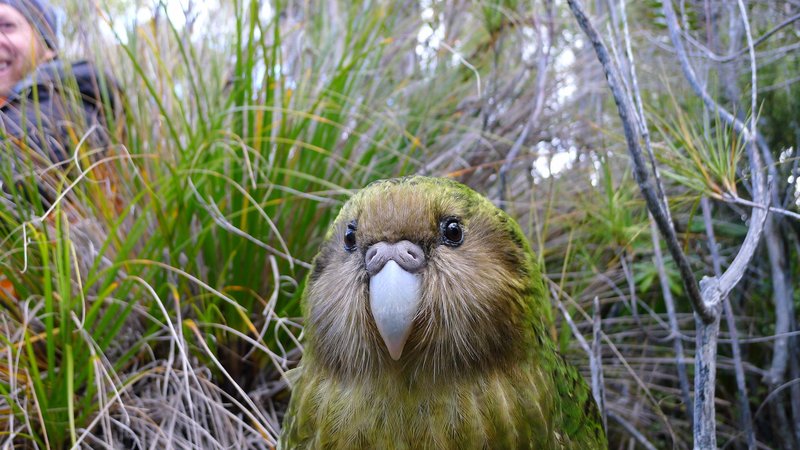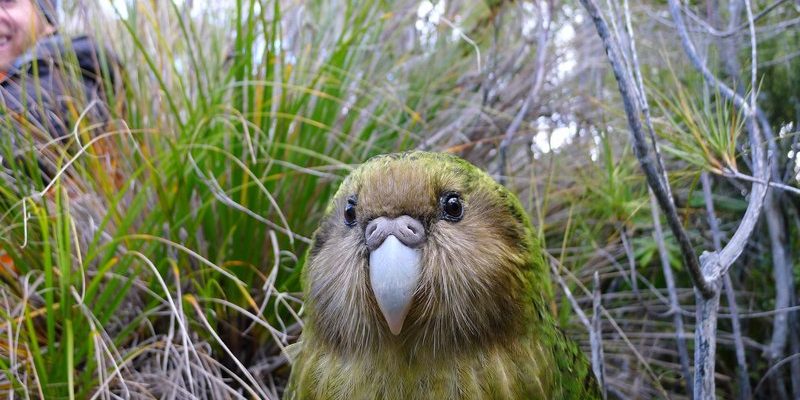
The Kakapo is one of the most fascinating birds you’ll ever come across. Imagine a parrot that can’t fly, has a distinct green and yellow plumage, and is nocturnal. That’s right! This unique bird is native to New Zealand and stands out not just for its unusual traits but also for its captivating story of survival. If you think of it as a big, fluffy, green friend who is as unique as they come, you’re on the right track.
There’s something truly intriguing about the Kakapo. Once widespread across New Zealand, these birds faced dramatic declines due to habitat loss and predation by introduced species such as cats and rats. Today, conservation efforts are intense, and each Kakapo is monitored closely as part of a dedicated recovery program. So, what makes this bird so special? Let’s explore together!
Physical Features
The Kakapo’s appearance is striking. It has a robust body, resembling a small owl, and can weigh anywhere from 2 to 4 kg (4.4 to 8.8 lbs). Its feathers are an alluring mix of green and yellow, giving it a natural camouflage in the forest. You might notice that the Kakapo has a large, broad beak, which is quite useful for cracking open hard seeds and fruits—its main source of food.
One fantastic feature is the Kakapo’s large, expressive eyes. They help make the most of its nocturnal lifestyle. These birds are primarily active at night, which means they have adapted to see well in the dark. If you’re out in the wild, spotting one can be quite a challenge—perfect for a game of hide-and-seek! One of the most charming traits about them is their playful nature; they often engage in curious behavior, hopping around and investigating anything that may intrigue them.
Unlike many birds, the Kakapo does not possess strong flight muscles. Instead, it relies more on its powerful legs for climbing and moving around the forest floor. This makes them excellent climbers but also ensures that their safety is often at risk from predators. With their inability to take to the skies, conservationists have had their work cut out for them, ensuring these charming birds remain protected in their natural habitats.
Habitat and Distribution
The Kakapo is deeply linked to New Zealand’s ecosystems. Traditionally, it thrived in a range of habitats, from lush forests to scrublands. However, as humans expanded their footprint, much of this habitat was lost. Today, the Kakapo is primarily found on predator-free islands, such as Codfish Island (Whenua Hou) and Anchor Island, thanks to rigorous conservation efforts.
These islands provide a safe haven away from the invasive species that once decimated their populations. The environment here is rich with the trees and plants that Kakapos depend on for food. Forests filled with native species like rimu, kahikatea, and totara form a vibrant dining table for these birds. Conservationists have worked hard to restore these habitats, creating a more welcoming space for our feathered friends.
As you can imagine, the Kakapo’s habitat needs are quite specific. The presence of fruit-bearing trees is crucial for their diet, and these birds also prefer areas where they can safely navigate and breed. This means that any effort to support the Kakapo must also include ensuring that their natural habitats remain healthy and thriving. It’s a big job, but it’s one that many are willing to take on.
Diet and Feeding Habits
The diet of the Kakapo is primarily herbivorous, meaning they feast mainly on plant material. They particularly enjoy fruits, seeds, nuts, and flowers. Some of their favorites include the fruits of the rimu tree and the leaves of the kahikatea. It’s a bit like a delightful salad bar in the forest!
What’s fascinating is the way Kakapos forage. They’re known to be slow and methodical, taking their time to select the best morsels. Since they’re nocturnal, they spend a considerable amount of time during the night searching for food. This slow approach means they can be vulnerable to predators, reinforcing the importance of their safe habitats.
Interestingly, the Kakapo has a unique way of digesting its food, which helps extract nutrients effectively. This makes them well-adapted to their herbivorous lifestyle. However, in captivity or during conservation efforts, maintaining a balanced diet is essential for their health. This is why habitat restoration is crucial, as it ensures that these birds have access to the right kind of food sources.
Breeding and Reproduction
Kakapos have a rather fascinating breeding system. They practice a form of mating known as “lekking,” where males gather in a particular area to display their charms—think of it as a bird version of a dance-off. During breeding season, the males perform elaborate displays and call out with deep, booming vocalizations that can echo for miles. These calls are not just for show; they attract females who are looking for a mate.
The breeding season is quite sporadic and primarily occurs every two to four years, depending on food availability. Once a female has chosen a mate, she will nest in a hollow or burrow, laying 2 to 4 eggs. The amazing part? The female is solely responsible for the incubation and raising of the chicks. After about 30 days, the eggs hatch, and the chicks are attentive and demanding.
Once hatched, the chicks rely heavily on their mother for food and warmth. They typically fledge, or leave the nest, around 10 weeks of age. However, they will stay close to their mother for quite some time even after leaving the nest. It’s a pretty wonderful family arrangement, ensuring the young have the necessary support as they begin their adventurous journey in the world.
Conservation Status and Efforts
Sadly, the Kakapo is classified as critically endangered, with a population of just over 200 individuals as of the latest reports. This number might seem small, but it’s crucial to understand that extensive conservation efforts are in place to protect this remarkable species. Organizations and volunteers work tirelessly to monitor each bird, ensuring they stay safe from threats.
The Kakapo Recovery Program is at the forefront of these efforts. This initiative involves habitat restoration, predator control, and a dedicated breeding program. Scientists carefully track each Kakapo’s movements with GPS collars, allowing them to gather valuable data on their behavior and needs. It’s a significant effort, but each Kakapo adds to the overall health of the population.
Moreover, public awareness is a vital part of conservation. Many people feel inspired to contribute through donations, volunteering, or spreading the word. With increased attention on the plight of the Kakapo, there’s a growing movement to protect not only these birds but also their habitats. Every little action can help ensure that future generations can enjoy the presence of these captivating creatures.
Interesting Facts About the Kakapo
| Common Name: | Kakapo |
| Scientific Name: | Strigops habroptilus |
| Habitat: | New Zealand, primarily on predator-free islands |
| Diet: | Herbivorous – fruits, seeds, nuts, flowers |
| Size: | About 60–70 cm (24–28 in) in length |
| Weight: | 2–4 kg (4.4–8.8 lbs) |
| Lifespan: | Up to 90 years |
| Conservation Status: | Critically Endangered |
FAQ
What does a Kakapo’s call sound like?
The Kakapo’s call is quite distinctive. Males produce deep, resonant booms that can travel long distances. These calls are not only meant to attract mates but also to establish territory among other males. If you were in the forest at night, you might hear these booming calls echoing around you, creating a hushed and magical ambience.
How does the Kakapo’s diet affect its conservation?
The Kakapo’s diet plays a crucial role in its conservation. Since it primarily feeds on native plants, the loss of these food sources directly impacts their survival. Conservation efforts focus on restoring their habitats to ensure these birds have access to the right nourishment. Without a stable and abundant food supply, breeding and overall health can suffer, making habitat protection vital.
Why can’t Kakapos fly?
Kakapos have evolved without the need for flight, mainly due to their island habitat where predators were minimal. Over time, they developed strong legs for climbing and moving on the ground, but their wing muscles are not powerful enough for flying. This flightlessness, while cute, has made them more vulnerable to threats, which is why conservation efforts are so important.
How long do Kakapos live?
Kakapos have a remarkable lifespan, living up to 90 years in some cases. This longevity is another reason why ensuring a stable population and safe habitats is essential. Since they reproduce infrequently and have low reproductive rates, the survival of each individual is crucial for the future of their species.
Are there any Kakapo conservation programs I can support?
Absolutely! There are several organizations dedicated to Kakapo conservation, notably the Kakapo Recovery Program. They often welcome donations and volunteers, helping you contribute to their efforts. You can also raise awareness through social media, telling others about these wonderful birds and the importance of their protection.
What does Kakapo mean in Maori?
The name “Kakapo” in Maori translates to “night parrot.” This name reflects their nocturnal habits and also connects them deeply to New Zealand’s indigenous culture. The connection is significant, as it emphasizes the importance of protecting both the Kakapo and their natural environment for future generations.
How do scientists monitor Kakapo populations?
Scientists use advanced tracking methods, such as GPS collars, to monitor Kakapo populations. These devices help track their movements, behaviors, and breeding success. This data is invaluable in understanding how to protect and support the Kakapo population, ensuring they thrive in their natural habitats.
Where can I see Kakapos in the wild?
Because of their critically endangered status, seeing Kakapos in the wild is quite rare. However, they are primarily found on predator-free islands in New Zealand, such as Codfish Island and Anchor Island. Some conservation programs also offer guided tours where visitors can experience the beauty of these birds in a safe and responsible manner.
What role do Kakapos play in their ecosystem?
Kakapos are significant members of their ecosystem as seed dispersers. By consuming fruits and seeds and moving through the forest, they help promote plant growth and diversity. Their presence supports the overall health of their habitats, making them integral players in maintaining ecological balance in the regions they inhabit.
Can Kakapos be kept as pets?
Keeping Kakapos as pets is not permissible, mainly due to their critically endangered status and the extensive care they require. They are wild animals with specific needs that can only be met in their natural habitats. Supporting conservation efforts is a much better way to appreciate these extraordinary birds while ensuring their survival.

